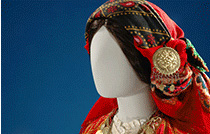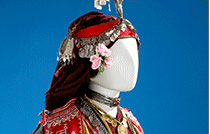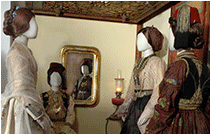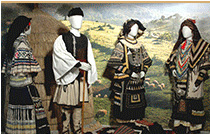The exhibition presents 55 costumes from Macedonia and Thrace and neighboring areas, historically confirmed extensions of Greece's northerly territories (Northern Macedonia, Eastern Thrace, Eastern Rumelia, the Black Sea littoral and Asia Minor) that were inhabited by cohesive substantial communities conscious of their origin, plus some traditional masquerade costumes.
Traditional costumes are those worn in the pre-industrial age. In Macedonia and in Thrace this period lasted until the 1950s.
The manner in which these costumes were developed was governed by the laws of tradition: the process was oral and unwritten handed down from one generation to the next, mother to daughter, craftsman to apprentice. While traditional costumes did not follow fashion, they were influenced by fashion. The changes were small, the pace slow, because in traditional society any change had to be generally accepted by the community as a whole.
Traditional costumes clothed and ornamented the body, protected it from visible dangers (cold, heat, wounds) as well as invisible ones (evil eye, evil hour, witchcraft e.t.c.) and constituted a sort of code identifying the sex, age, occupation, ethnicity, religion, birthplace or native region, social position, family status (married woman, widow, spinster) and emotional situation (mourning, joy).
The term costume or dress refers also to a set of garments, jewellery and accessories worn together and covering the body from top to toe-headdress to shoe buckles.
In traditional society jewellery did not merely serve the primitive need for decoration and distinction, nor did it only have a practical purpose, as an easy way of saving and transporting property in time of need: as symbols, religious or magical, articles of jewellery were intended to protect the wearer and ward off evil. The points of the body upon which jewellery was worn are those which each society holds to be most exposed to the baneful influence of supernatural powers. Like women or embroidered motifs, bits of mirror, sewuins, beads, shiny metallic threads, everything that we today consider as decorative, jewellery served to protect the body of the wearer.
In Northern Greece it is very rare for a traditional costume to be worn in a single locality. The same dress, or variations of it, was worn in neighboring villages, and any openings from these primarily code identifying the sex, age, occupation, ethnicity, religion, birthplace or native region, social position, family status (married woman, widow, spinster) and emotional situation (mourning, joy).
The term costume or dress refers also to a set of garments, jewellery and accessories worn together and covering the body from top to toe-headdress to shoe buckles.
In traditional society jewellery did not merely serve the primitive need for decoration and distinction, nor did it only have a practical purpose, as an easy way of saving and transporting property in time of need: as symbols, religious or magical, articles of jewellery were intended to protect the wearer and ward off evil. The points of the body upon which jewellery was worn are those which each society holds to be most exposed to the baneful influence of supernatural powers. Like women or embroidered motifs, bits of mirror, sewuins, beads, shiny metallic threads, everything that we today consider as decorative, jewellery served to protect the body of the wearer.
In Northern Greece it is very rare for a traditional costume to be worn in a single locality. The same dress, or variations of it, was worn in neighboring villages, and any openings from these primarily closed, endogamous, societies would be made towards villages where people wore the same clothes. The same style of dress meant, in other words, a shared cultural identity.
The exhibition includes a "Costume Diffusion Map" that shows the diffusion of the costumes presented in the exhibition, from 1860 to 1960. It was prepared on the basis of the relevant literature and the documentation supplied by our field research, and represents an initial attempt to record the information that has been gathered to date.









 Follow us
Follow us 



